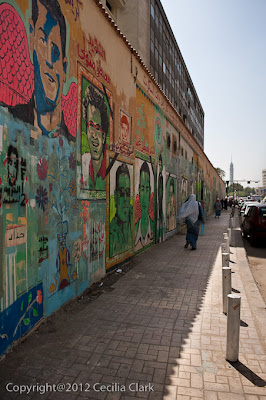Today, like a gift from Egypt Air, our bags arrived. That was a good start. After getting reacquainted with our possessions, we went to the Khan. The Khan El Khalili is the most amazing market of surprising nooks and crannies. There were not many shoppers and very few tourists at the Khan. We stopped at my favorite merchants to see their old silver jewelry. Mr. Ali is in the first photo with his picture of himself and the Queen of Spain behind him. He's a very good salesman and he has some great treasures. He said the Queen of Spain visits his shop every 2 to 3 years.
Another of my favorite merchants is Alaa who owns Kenoz Jewelry. He's very knowledgeable on all types of old Egyptian jewelry. There was a period of time when Berber and Bedouin jewelry was not popular so it was bought for the weight of the silver only and melted down. Mr. Alaa offers a premium price to those who want to sell their silver jewelry. His price is better than what they would get for the weight of the silver so he has a good inventory and less jewelry is destroyed.
The young woman above sells new silver jewelry parts: fastenings, findings, chains, beads from Thailand and Egypt. She said 100% of her business was foreign customers. Now her business is down 80%.
Some sights in the Khan El Khalili:
A guava salesman from Luxor:
Just people who wanted their photos taken:
An elusive bread man. They move so fast it's very hard to get a photo. He's shaking his finger at me.
Inside the Spice Market:
Farther inside the spice market where spices are ground or pressed to make oils. Just walking into this area you can feel the dust in your throat. It causes immediate coughing. Imagine these people working their every long day with no breathing protection.
A supplier of herbs and essential oils. The writing on the packages is in Cyrillic because they ship their concoctions to Russia.
It was nice to have some time to ourselves to visit and explore the Khan. And, we did our best to stimulate the Egyptian economy. This evening we had dinner at Maison Thomas in Zamalek with Hadeel who had to be home by 9:30 pm.
Because it was so early for Cairo and for our friend Vivian, we stopped by her apartment for a visit before going back to our hotel. She is an American who has made Cairo her home. She remained through the revolution, and said that life on Zamalek was much the same as usual. The grocery remained open and was well stocked. People began watching out for each other and neighbors who had never talked finally met each other.























































